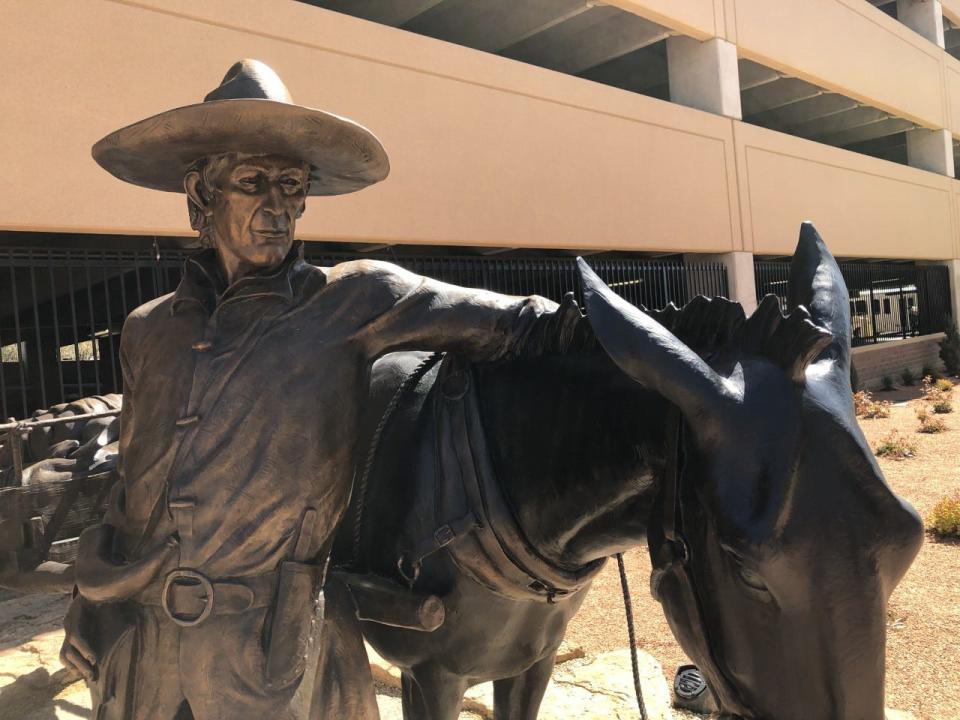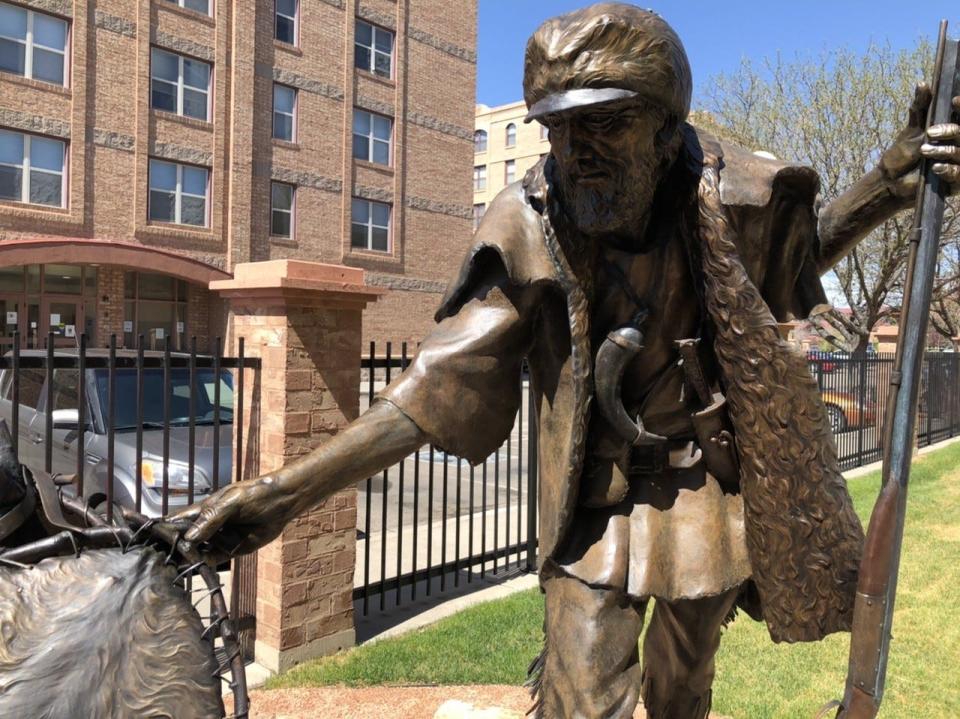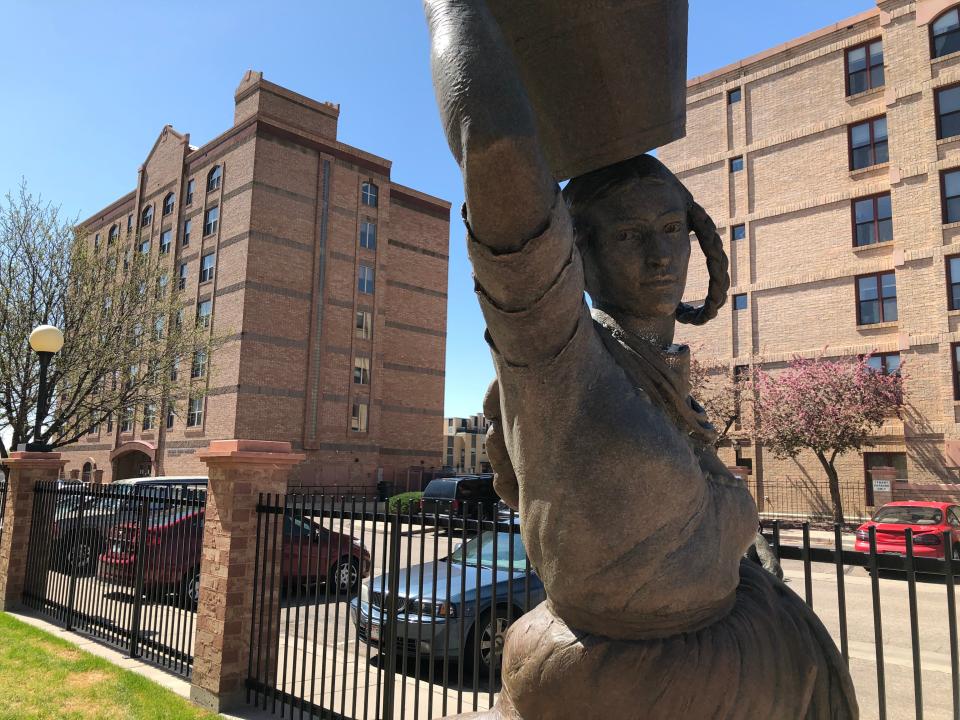3 pioneers are immortalized in the new Walk of Legends Park. Here's who they were
- Oops!Something went wrong.Please try again later.
- Oops!Something went wrong.Please try again later.
Amid bustling Downtown streets, new statues crafted by nationally renowned artists honor three "legends" of Pueblo's frontier past.
Statues of Charles Autobees, Marcelino Baca and Teresita Sandoval have been installed in the new Walk of Legends Park at 301 Central Main St.
The Pueblo Urban Renewal Authority will host a dedication ceremony for the park at the Pueblo Convention Center from 1 to 3 p.m. on Saturday, May 6.
Walk of Legends Park is across the street from the former site of the three legends' stomping grounds: El Pueblo trading post. Autobees, Baca and Sandoval were among the Mexican citizens that traveled north in the mid-19th century to do business at the adobe trading post.
While the trading post is long gone, the legacies of Autobees, Baca and Sandoval have withstood the test of time.

Charles Autobees (1812-1882)
Born in St. Louis to parents of French-Canadian and Native American descent, Charles Autobees' French surname has been spelled several ways, including Autobee, Ortivis and Urtebise.
His father, Francis, died when Autobees was 3 years old. As a teenager, Autobees headed west to trap beaver along the Missouri River. In adulthood, he headed to what is now Taos, New Mexico and worked for Simeon Turley's distillery in Rio Hondo.
The sculpture of Charles Autobees in Walk of Legends Park was created by Wyoming-based artist Dustin Payne. It features Autobees standing alongside a mule carrying barrels of whiskey in a wagon. Soon after El Pueblo was established in 1842, Autobees and his mules brought 10-gallon barrels of whiskey to the post. Liquor proved to be profitable at El Pueblo, according to a plaque near Autobees' statue.
Autobees also carried fur pelts and could speak seven languages. In 1861, he became one of Huerfano County's first three commissioners.

Marcelino Baca (1808-1862)
Those familiar with fur trapping and hunting along the Santa Fe Trail knew Taos-born Marcelino Baca to be the best trapper there was.
When he wasn't fur trapping, he was trading fur pelts, and El Pueblo was the place to trade with him. In his creation, Huberto Maestas, a sculptor from San Luis, Colorado, depicts Baca as a mountain man cloaked in fur with a powder horn around his neck and a rife in his left hand.
When the profitability of pelts declined, Baca became a rancher and raised livestock on property near El Pueblo. On Dec. 24, 1854, members of the Ute tribe led by Chief Tierra Blanco arrived at Baca's homestead. The Utes, distraught by sickness and starvation, reportedly stole horses from Baca and headed for El Pueblo, according to History Colorado. All but three inhabitants of El Pueblo were killed in a raid on the post.
Baca would later return to New Mexico. He was killed in Valverde while fighting for the Northern cause during the American Civil War.

Teresita Sandoval (1811-1894)
Teresita Sandoval helped build and manage El Pueblo. Many stories have been told about her, but sculptor Deon Duncan was able to find only one depiction of her likeness.
The picture is a sketch by Alexander Barclay, a London immigrant who would later become Sandoval's third husband. Barclay's sketch features Sandoval wearing a red skirt and carrying a laundry basket on her head, sporting braids similar to those of Queen Victoria. This depiction serves as inspiration for Duncan's sculpture in the Walk of Legends.
Before she met Barclay, Sandoval grew crops on a homestead with her second husband, Matthew Kinkead, in addition to taking part in the operation of El Pueblo. Sandoval and Kinkead also raised, traded and sold buffalo, according to History Colorado. In addition to a laundry basket, Duncan's statue of Sandoval features a Texas Patterson revolver.
"I picture her as a woman with a lot of moxie and a lot of wherewithal," Duncan said.
Pueblo Chieftain reporter James Bartolo can be reached at JBartolo@gannett.com.
This article originally appeared on The Pueblo Chieftain: Pueblo's Walk of Legends Park depicts 3 pioneers in sculpture

